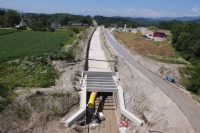Koralm, Graz - Klagenfurt Railway Line, Mittlern - Althofen Section, Contract Section 60.3 (St. Kanzian)
Client: Austrian Railways Infrastructure AG
Development Period: 1996 bis 2020
The cities Graz and Klagenfurt will soon be connected with the new, 124 km long Koralm high performance railway line.
The objective contract section comprised a new track with a length of 3.5 km, two railway bridges, the environmental tunnel Peratschitzen (length 230 m, cut-and-cover method), the Srejach Tunnel (length 630 m, cut-and-cover top-down method) as well as the Untersammelsdorf Tunnel (length 660 m, mining technique).
In the project area, the underground is built of lacustrine sediments with a thickness of several metres. The material is described as fine sand with varying silt content as well as silt-clay mixtures with a soft to stiff, and locally also pulpy, consistency.
BGG Consult attended to this project section in the fields of geotechnics, hydrogeology and geology since the beginning of the planning phase. First of all, expert's reports were prepared for the route selection procedure. In the EIA phase, the basics were established and documents regarding the groundwater and geology presented. Subsequently, the reports for the permission according to railway law were compiled, based on intense subsoil investigations.
Additional attendance was required during the tender phase for further extensive exploration measures and field tests (e.g. jet-grounting test field and well test field).
During construction, the work was supervised in the fields of geotechnics and hydrogeology.
Srejach Tunnel:
The Srejach Tunnel was established by means of the cut-and-cover top-down method, protected by an intermittent bored pile wall with a jet-grouted sealing of the interspaces and a continuous bracing of the base, also by means of jet-grouting. Because of the high groundwater level and local sand layers, ground water lowering measures were necessary during construction. For this, gravitatively operated wells were used. An intensive supervision of the pumping gear with a short reaction time was of great importance because the groundwater raised fast in case of an outage.
Untersammelsdorf Tunnel:
The cross section of this tunnel is situated mostly in silty-sandy lacustrine sediments. For the protection of the attack, intermittent bored pile walls with jet-grouted sealing of the interspaces were consistently lowered in the area of the side walls from above ground. Additionally, the tunnel roof was protected by a jet-grouted arch and the tunnel face by jet-grouted columns, both implemented from above ground.
The intense exploration measures, especially the test fields, which were finetuned to the complex construction measures, provided a solid decisional base for a technically correct construction procedure.
November 2020
